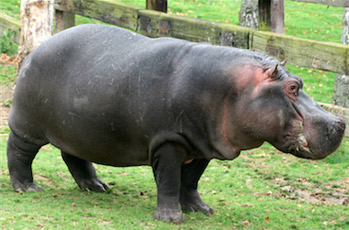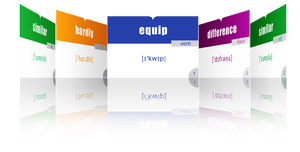Описане бегемота на английском языке
- Подробности
- 17600
 |
Прилагательные, описывающие Бегемота |
|
1 |
large |
огромный |
|
2 |
fat |
толстый |
|
3 |
calm |
спокойный |
|
4 |
slow |
медленный |
|
5 |
short-legged |
коротконогий |
|
6 |
heavy |
тяжелый |
|
7 |
clumsy |
неуклюжий |
|
8 |
thick-skinned |
толстокожий |
КРАТКОЕ ОПИСАНИЕ БЕГЕМОТА:
|
Look at the picture. |
Посмотрите на картинку. |
|
You can see a hippo. |
Вы можете увидеть бегемота. |
|
Its name comes from ancient Greek for "river horse". |
Его название происходит от древнегреческого «речной лошади». |
|
It is standing in the grass. |
Он стоит в траве. |
|
It’s big and fat. |
Он большой и толстый. |
|
It has two small ears. |
У него есть два маленьких уха. |
|
It has two small eyes. |
У него есть два маленьких глаза. |
|
Its legs and neck are short. |
Его ноги и шея короткие. |
|
It has massive body and huge head. |
Он имеет массивное тело и огромную голову. |
|
Its belly is big. |
Его живот большой. |
|
Its nostrils are very wide. |
Его ноздри очень широкие. |
|
Its skin is extremely thick. |
Его кожа очень толстая. |
|
It looks cute but it could be very dangerous when it's disturbed. |
Он выглядит милым, но он может быть очень опасным. |
|
Hippos are omnivores. |
Бегемоты - всеядные. |
Общая информация о бегемота:
Look at the picture. You can see a hippo. The common hippopotamus (Hippopotamus amphibious), or hippo, is a large, mostly herbivorous (1), semi-aquatic (2) mammal that lives mainly in Africa. The name comes from ancient Greek for "river horse". Historically, the pig was considered (3) the closest relative of the hippopotamus. However, recently, whales are believed to its closest species.
The eyes, ears, and nostrils of the hippo are positioned high on the roof of their skulls. The hippo's jaw is powerful and it can open its mouth to almost 180°. Its teeth, namely (4) incisors (5), can reach up to 40 cm in length, while their canine (6) teeth reach up to 50 cm. Its legs are so short that its belly almost touches the ground when it walks. The hippo's huge head can reach up to a quarter of its total body weight, up to 900 kg. The hippo's neck is very short and practically not distinguishable (7). Its eyes are small and surrounded by large eyelids. Its nostrils are very wide, directed (8) upwards and are able to close tightly. The hippo's skin is extremely thick, up to 4 cm. and it's almost hairless.
Hippos shares second place with the rhinoceros as the largest land mammals after elephants. Some male hippos can reach up to 4000 kg. Usually, male hippos have an average weight of about 1600 kg, while the average female weighs about 1400 kg. The body length of an adult specimen (9) is at least 3 m, but can reach 5.4 m. A hippo's tail can reach a length of 56 cm.
The Hippo has a barrel (10) - shaped body with short legs and long muzzle. They have relatively short legs. Despite the fact that they are bulky (11) animals, they can gallop for short distances at 30 km/h, although normally they trot (12).
Many countries seriously considered the possibility of turning hippos into a domesticated beef like pigs and cows.
The hippopotamus is a semi-aquatic animal. Most of its waking time is spent in river water. It leaves the water for land only at night for several hours to feed.
Despite being semi-aquatic and having webbed (13) feet, an adult hippo is not a good swimmer, usually it walks on the bottom.
The behavior (14) of the hippopotamus is generally aggressive. Hippopotamus fights often lead to the death of one of the participants. Also, cases of attack on humans by hippo are frequent. The hippopotamus is the most dangerous animal for man in Africa.
The lifetime of a hippopotamus "in the wild" can be up to 40 years. In captivity, hippos can live much longer, up to 50 years.
| Карточки PDF-1 PDF-2 |
Vocabulary (используйте карточки для слов, которые сложно запоминаются):
|
1 |
herbivorous [hərˈbɪvərəs] |
травоядный |
|
2 |
semi-aquatic [ˈsemi-əˈkwætɪk] |
полуводный |
|
3 |
consider [kənˈsɪdər] |
считать, считаться |
|
4 |
namely [ˈneɪmli] |
именно, а именно |
|
5 |
incisor [ɪnˈsaɪzər] |
резец, резцовый зуб |
|
6 |
canine [ˈkeɪnaɪn] |
клык |
|
7 |
distinguishable [dɪˈstɪŋɡwɪʃəbl] |
различимый, отличимый |
|
8 |
directed [dɪˈrektəd] |
направленный |
|
9 |
specimen [ˈspesɪmən] |
образец, экземпляр |
|
10 |
barrel [ˈbærəl] |
бочка |
|
11 |
bulky [ˈbʌlki] |
грузный |
|
12 |
trot [trɑːt] |
идти рысью |
|
13 |
webbed [webd] |
перепончатый |
|
14 |
behavior [bəˈheɪvjər] |
поведение |






 Как правильно изучать английский язык по карточкам (статьи)
Как правильно изучать английский язык по карточкам (статьи)